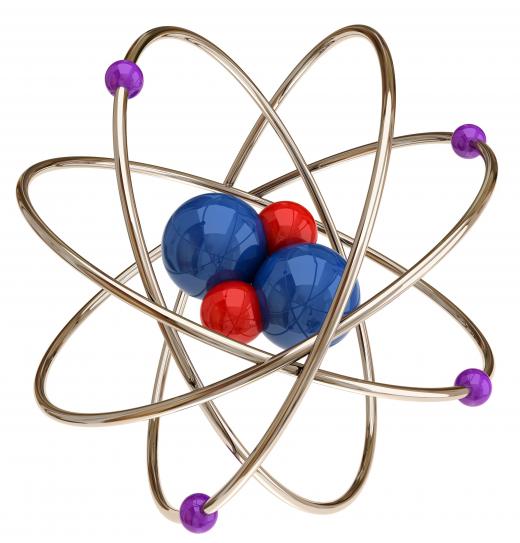What is an Electron?
 Nicole Madison
Nicole Madison
An electron is a subatomic particle with a negative electric charge that is equal, but opposite to, the positive charge of a proton. These two particles, together with neutrons, form atoms, with the protons and neutrons residing in the nucleus, and the electrons in surrounding orbitals, held in place by the electromagnetic force. They are involved in chemical bonding, can flow through some materials as an electric current, and are responsible for the solidity of solid objects. The particles have a tiny mass, about 1/1836th of the mass of a proton, and are thought to be fundamental, that is, not made up of smaller components.
Although it is often convenient to think of electrons as tiny, point-like particles, they can, in common with other subatomic particles, sometimes behave as waves. This is known as the wave-particle duality. Since no one can actually see an electron, even using the most powerful and sensitive instruments available, it is only possible to construct models to try to explain their behavior. In some cases a “particle” model works best and in others, a “wave” model. Most of the time, however, these entities are referred to as particles.
Electrons in Everyday Life

Electrons play a fundamental role in everything that humans experience on a day-to-day basis. Their mutual electrical repulsion prevents solid objects from passing through one another, despite the fact that the atoms from which the objects are made are mostly empty space. These particles are also responsible for allowing atoms to join together to form the molecules that make up the Earth and life itself. Modern civilization and technology are heavily reliant on electricity, which involves movement of electrons.
Atoms, Elements and Molecules

The properties of the chemical elements depend on the number of electrons they have, and their arrangement within the atom. These factors determine how atoms of an element will combine with other atoms to form molecules. When atoms combine, they do so in such a way as to achieve a lower level of energy. The electrons can be thought of as being arranged into concentric shells, each with a maximum number that it can contain. Usually, the lowest energy state is achieved between two atoms when both are able to fill up their outermost shells.
There are two main ways that atoms can combine, or form a chemical bond, with one another. In ionic bonding, an atom donates one or more electrons to another atom of a different element, normally in such a way that both achieve full outer shells. Since an atom normally has the same number of electrons as protons, it is electrically neutral, but losing or gaining some will give it a positive or negative charge, forming an ion. A metal will tend to donate electrons to a non-metal to form an ionic compound. The molecule is held together by the electrical attraction between the positively charged metal and the negatively charged non-metal.
In a covalent bond — which forms between non-metals — atoms combine by sharing electrons to achieve a lower energy state, usually, again, by filling up their outer shells. For example, a carbon atom, which is four short of a full outer shell, can form covalent bonds with four hydrogen atoms, each one electron short, forming a molecule of methane (CH4). This way, all five atoms share a full shell. Covalent bonds hold together the complex organic molecules that are essential to life.
Electricity
The movement of electrons from one place to another manifests itself as electricity. This can take the form of “static” electricity, where friction causes these particles to move from one material to another, leaving both electrically charged, and able to exert an attraction toward other objects. This was first documented in ancient Greece, when the effect was produced by rubbing amber with fur. The word electron, in fact, comes from the Greek word for amber. A device called a Van de Graff generator uses this effect to generate very high voltages that can produce large sparks.
The most familiar form of electricity, however, is the electric current that is supplied to homes and industry to provide light and heat, and to power various devices and processes. It consists of a flow of electrons through a suitable material, known as a conductor. The best conductors are metals, because their outer electrons are loosely held and can move about easily. The movement of a conductor within a magnetic field can produce a flow of electrons within it, an effect that is used in the large-scale generation of electricity.
History
The idea that electricity might come in small, indivisible units had been around since the early to mid 19th century, but it was in 1894 that the Irish physicist G. Johnstone Stoney first used the term electron to describe the postulated fundamental unit of negative electric charge. Three years later, the British physicist J. J. Thompson identified it as a subatomic particle. It wasn’t until 1909 that its charge was measured by Robert Andrews Millikan, an American experimental physicist, by an ingenious experiment well known to physics students. He suspended oil droplets of various sizes in an adjustable electric field, and calculated the amounts of charge required to prevent them falling by gravity. It turned out that the values were all multiples of the same tiny unit, which was the charge on a single electron.
AS FEATURED ON:
AS FEATURED ON:












Discussion Comments
Electrons have no measurable mass. No quanta. They are not physically definable as a particle. An electron, in practical electrical engineering, is a field perturbation. Where is the proof that this perturbation has a mass and can be observed as a particle? There is none. J.J. Thompson denied that an electron was a particle until he was offered the Nobel Prize.
Why is the photo electric effect only for bound electrons?
Millikan, Compton, Stoney, all these guys. Are you sure about the orbit the atom? are they particles? or waves? referring to quantum.
OK- we could also call it a set of coupled angular momentum vectors precessing at constant angular velocity with uncertain to uncertain components, or we could call it a set of superimposed probability amplitudes (waves - really wave functions) or we could call it a spinning relativistic particle traveling comparable to the speed of light. We could say it discrete energy states, corresponding to atomic structure, or we could say that it has continuous energies corresponding to a free electron.
The only answer to the question "What is an electron?" can only honestly be stated as "We don't really know!"
Do electrons play any part in the faculty of ESP, whether by their presence or their absence?
anon5576: Why are you trying to put down wise geek? just let them give you the information that is mostly general and leave them be. they are helping me with my whole 10th grade project and i think the info they have here is very helpful.
what are some examples of electrons?
how does it work in other things?
who discovered electrons?
Are you sure about the orbit the atom?. are they particles? or waves?. referring to quantum.
discovery of electrons?
why is it called an electron?
what are some examples of electrons?
Post your comments